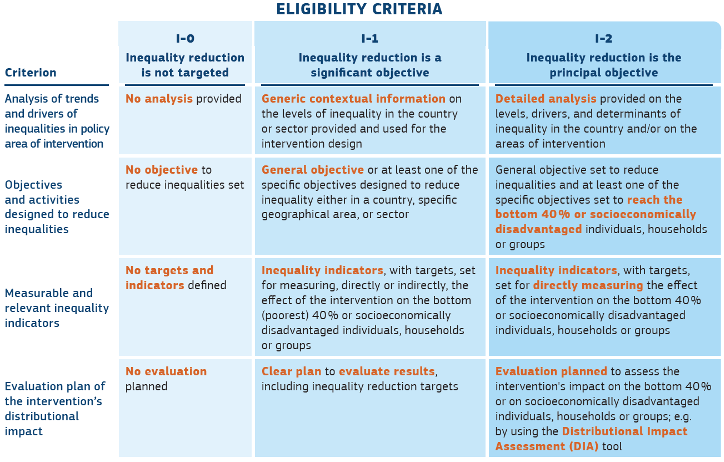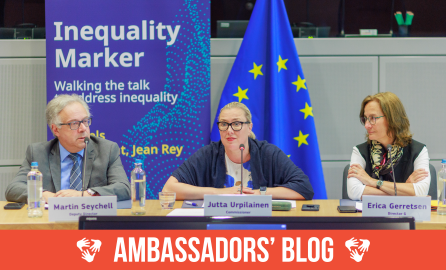Global inequality has increased in recent years, exacerbated by the pandemic, climate change, and ongoing conflicts. Recognising the critical need to address this growing issue, the European Commission has introduced a pioneering tool—the Inequality Marker (I-Marker), a robust tracking and benchmarking system that accurately measures the contribution of all Directorate-General for International Partnerships (DG INTPA) interventions towards reducing inequalities, also capturing their multidimensionality, in complement to horizontal inequalities (measured through the gender and disability markers).
What is the I-Marker?
Publicly and politically launched in June 2023 by the Commissioner for International Partnerships Jutta Urpilainen, the I-Marker represents a significant step forward in the European Commission's efforts to promote inclusive and sustainable development. The I-Marker helps DG INTPA better understand, track and benchmark the impact of its work on inequalities across all sectors by assessing whether and to what extent inequality reduction is an objective of a donor’s intervention and, therefore, how likely it is to have an impact on reducing inequalities. This is customarily the case of those interventions designed to benefit, to a larger extent, the bottom (poorest) 40% or other socio-economically disadvantaged individuals, households or groups, such as women, young people or people with disabilities.
How to apply the I-Marker to interventions?
A set of criteria has been developed to establish whether inequality reduction is the principal objective (I-2), a significant objective (I-1) or not targeted (I-0):

The LAMARR project, part of the Team Europe Initiative (TEI) on Digital Jobs in El Salvador, exemplifies an action scored as I-1. Key elements that contributed to its I-1 rating include:
-
Analysis of Informality: Comprehensive analysis of the informal sector and the contextual challenges faced by vulnerable groups.
-
Specific Objectives: Clear objectives to promote digital job creation and socioeconomic integration, specifically targeting disadvantaged youth and informal workers.
-
Disaggregated Indicators: At least one indicator disaggregated by income level to ensure targeted impact measurement.
-
Evaluation Plan: A robust evaluation plan to assess the project's impact on the most vulnerable populations.
First I-Marker Results
On 3 July, during an event hosted by the Commissioner for International Partnerships, Jutta Urpilainen, the first results of the I-Marker were released, showcasing the contribution of DG INTPA’s actions in tackling inequalities. In 2023, 59% of all new actions funded by DG INTPA’s budget had a substantial focus on reducing inequality, with 13% targeting it as the main objective and 46% as a significant objective. From a regional perspective, Sub-Saharan Africa saw 76% of new actions substantially contributing to inequality reduction in 2023, followed by Latin America and the Caribbean at 61%, and Asia and the Pacific at 59%. These results reflect DG INTPA’s significant efforts and achievements, reinforcing the I-Marker's role as a catalyst for inclusive development.1
Challenges and Future Directions
Despite the positive outcomes, several challenges remain. Assessing the full extent of the European Commission's efforts to reduce inequalities requires systematic application of the I-Marker. The lessons learnt from the initial implementation phase underscore the need for capacity-building initiatives and comprehensive guidelines to ensure the I-Marker’s effective application across all development interventions, as well as its broader application to the European Fund for Sustainable Development Plus (EFSD+). Particular focus will be given to DG INTPA’s Equality Flagships,2 which have transformative potential to reduce inequalities.
As the Commissioner for International Partnerships, Jutta Urpilainen, said on 3 July: “Now that we know where we stand, we need to continue improving the design of our actions from an inequality lens. […] I want to encourage all actors in the development space to implement the Inequality Marker.”
Looking ahead and in line with Council Conclusions (21/11), encouraging development cooperation partners to adopt the I-Marker will significantly enhance our collective ability to reduce inequalities. Agence Française de Développement (AFD) has already aligned their internal metrics with the I-Marker.
Conclusion
The introduction of the Inequality Marker marks a pivotal moment in the European Commission's commitment to reducing inequalities. By providing a structured and evidence-based framework for evaluating and enhancing the impact of development projects, the I-Marker ensures that the needs of the most vulnerable populations are prioritised. As the European Commission continues to refine and expand this tool, it sets a powerful example for other international organisations and development actors to follow, fostering a more inclusive and equitable world for all.
Photo credit: Christophe Licoppe, European Union, 2024 | Source: EC - Audiovisual Service
1. For more information about the I-Marker results, you can consult the official web release.
2. Equality Flagships include the following: GG flagship Green in Lao PDR; GG flagship Demography and Social Inclusion in Uganda; GG flagship Human Development in Zambia; GG flagship Green Deal in Peru; Flagship aligned with GG priorities Inclusion pour la stabilité and Pacte Vert pour les Jeunes in Burkina Faso; Flagship aligned with GG priorities Decent Work in Bangladesh; GG flagship Inclusive and Equal Societies in Regional Latin America; GG flagship Human-centred Digitalisation in Kenya; GG flagship Jobs for Future in South Africa; and Flagship Reducing Inequalities in Paraguay.
Further information
A Social, Green and Digital Transition, Council conclusions, Council of the European Union (2023), November,
Addressing inequalities in partner countries, Council conclusions, Council of the European Union (2019), November.
Addressing income inequalities through development cooperation – A quick guide, Directorate-General for International Partnerships, European Commission (2022), Volume 1, Volume 2, Volume 3.
Resources on the I-Marker: Guidelines, one-pager, video and e-learning module. Official web release about the first I-Marker results.


(2)
Log in with your EU Login account to post or comment on the platform.
Thank you for sharing.
As we discuss the energy transition and emerging technologies, we cannot ignore the most vulnerable: children and communities suffering from inequality. The European Union has the responsibility to lead the fight against climate change and implement the European Child Guarantee System, an urgent necessity to advance towards authentic social justice.
Initiatives like CitiVERSE and the VR/AR Industrial Coalition, with their regulatory sandbox, are vital steps, but we must be bold. In the meeting on June 26, 2024, the benefits of sandboxes for fostering innovation were discussed, but this is not enough. We must ensure a human-centered approach that not only prevents harm but also activates transformative change in our society.
Let’s imagine a European Union that integrates ecological and social footprints in all its actions. Regulatory sandboxes should be a real testing ground where norms are challenged, not merely a bureaucratic exercise.
The emergency of this transformation is clear: our policies must reflect the needs of all and serve as a vehicle for disruptive change. We are at a turning point. It is time to act boldly.
Thank you for reading the article and sharing your thoughts with our community!